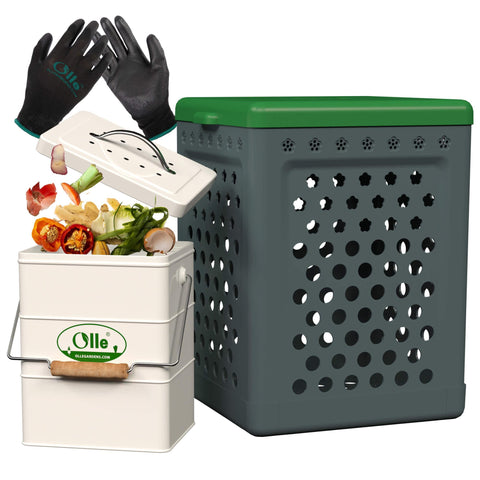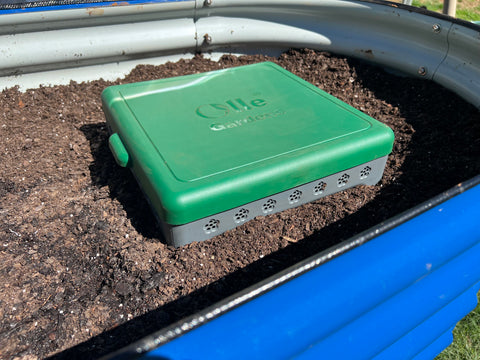Unlocking the Power of Composting: Create Your Own 'Black Gold'
In an era when sustainability and eco-friendliness are at the forefront of our minds, composting has emerged as a powerful and accessible way for individuals to make a positive impact on the environment. It's a simple yet highly effective way to reduce waste, enrich your garden beds soil, and contribute to a greener planet. In this article, we'll explore the art and science of composting and show you how to create your very own "black gold" - nutrient-rich compost that will transform your garden and help save the Earth.
Composting is like turning your kitchen and garden waste into pure gold for your plants and the environment. In this article, we'll walk you through the simple steps of making your own compost and reaping the rewards of this eco-friendly practice.
Why Compost?
Before delving into the how-to of composting, let's understand why it's so important:
Waste Reduction: Composting diverts organic waste from landfills, reducing the production of harmful greenhouse gases like methane.
Nutrient-Rich Soil: Compost is nature's fertilizer. It enriches soil with essential nutrients, making it more fertile and better able to support plant growth.
Water Retention: Compost helps soil retain moisture, reducing the need for excessive watering in your garden.
Erosion Control: The improved structure of compost-rich soil helps prevent erosion by binding soil particles together.
Chemical-Free Gardening: Composting reduces the need for synthetic fertilizers and pesticides, promoting natural and chemical-free gardening practices.

Getting Started
Now that you understand the importance of composting, let's get started on creating your own 'black gold.'
Step 1: Get a Compost Bin
The first step in your composting journey is acquiring a suitable compost bin. You have several options here:
Purchase a Compost Bin: Many garden centers offer purpose-built compost bins that are designed for efficient decomposition.
DIY Wooden Bin: If you're feeling crafty, you can build your own compost bin using wooden pallets or planks. This approach offers customization options and can be a great weekend project.
Repurpose an Old Container: Don't want to spend a dime? You can repurpose an old plastic container or trash bin. Just be certain that it has a lid.
Place your compost bin in a shaded area of your garden, away from direct sunlight. Covering the bin helps prevent excess moisture and retains heat, which accelerates decomposition. If you don't have outdoor space, consider using a small bin under your kitchen sink.
Step 2: Organize Your Waste
Not all waste belongs in your compost bin. To create high-quality compost and avoid unwanted visitors like rats, follow these guidelines:
Green Waste: Include items like fruit and vegetable scraps, coffee grounds, tea bags, and garden trimmings. These materials are rich in nitrogen and provide essential nutrients for your compost.
Brown Waste: Gather materials like cardboard, newspaper, dried leaves, straw, and small twigs. Brown waste adds carbon to your compost pile, balancing the carbon-to-nitrogen ratio.
Avoid adding items such as meat, dairy, oils, and cooked foods, as these can attract pests and produce unpleasant odors. Pet waste, diseased plants, and synthetic materials should also be kept out of your compost.
Step 3: Layer it Right
The key to successful composting lies in achieving the right balance between green and brown waste. Aim for slightly more brown waste than green. This balance ensures proper decomposition and prevents your compost from becoming too slimy or smelly.
Chop or shred your materials into smaller pieces before adding them to the bin. Smaller pieces decompose faster and create a more even compost texture.
Step 4: Help it Decompose
To speed up the decomposition process, turn your compost pile with a fork every one or two weeks. Turning the pile introduces oxygen, which is essential for the breakdown of organic matter. Proper aeration prevents your compost from becoming compacted and helps beneficial microorganisms thrive.

Step 5: Use Your 'Black Gold'
Composting requires a little patience. It may take several months before your compost turns into dark, earthy-smelling 'black gold.' When it reaches this stage and resembles rich soil, it's ready to use.
Here are some ways to put your compost to work:
Garden Enrichment: Spread your compost over your garden beds to improve soil structure, enhance water retention, and boost nutrient content. Your plants will thank you with lush growth and vibrant blooms.
Mulch: Use compost as a natural mulch to suppress weeds, regulate soil temperature, and reduce evaporation in your garden.
Share the Wealth: If you have more compost than your garden can handle, consider sharing it with friends and neighbors. It's a great way to foster community and encourage sustainable practices.
Using Your 'Black Gold'
Once your compost is ready, it's time to reap the benefits:
Garden Soil: Incorporate your compost into your garden bed soil to improve its fertility and structure. This will result in healthier plants and increased yields.
Potting Mix: Blend compost with potting soil to create a nutrient-rich mix for potted plants and seedlings.
Mulch: Spread compost as a protective layer over the soil to regulate temperature, reduce weed growth, and retain moisture.
Lawn Care: Topdress your lawn with compost to promote lush, green grass.
In conclusion, composting is a simple yet powerful way to reduce waste, nourish your garden, and contribute to a healthier planet. By following these steps and embracing the art of composting, you can turn your everyday kitchen and garden waste into 'black gold' that benefits both you and the environment. Start your compost pile today and watch your garden thrive while you reduce your ecological footprint.
